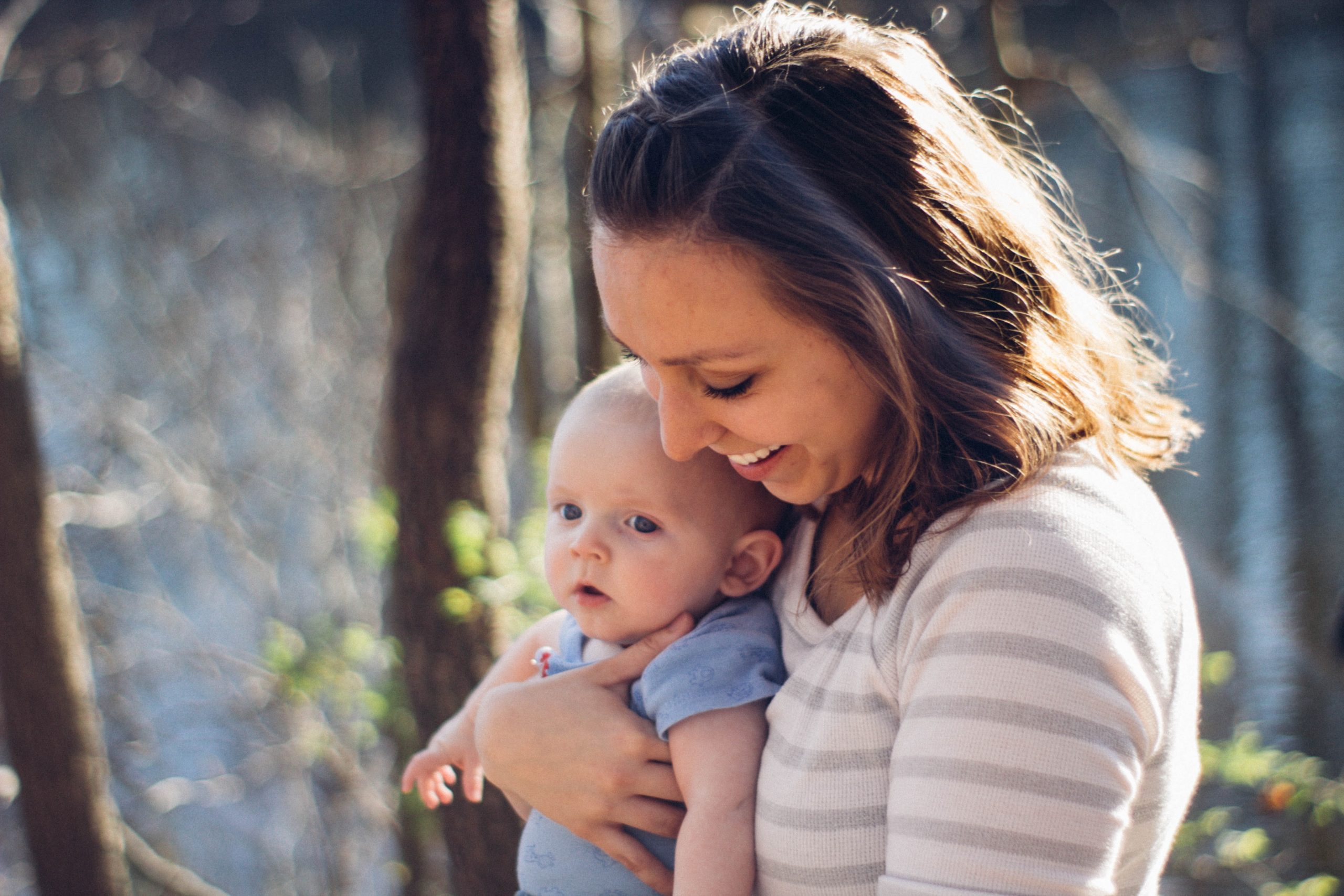Parents, we’ve all been there. It’s early in the morning, way before the crack of dawn, your baby cries for your attention, you walk over to their crib and bend down to pick them up, still half asleep yourself. As you pick them up, you’re jolted awake by a sudden twinge in your back. Uh oh.
This sequence of events is far too common among parents and makes us as chiropractors feel terrible that there isn’t more knowledge out there to show parents how to prevent the back pain that’s a result of holding or picking up their children incorrectly.
Holding your baby correctly, along with regular chiropractic adjustments and proper posture and alignment, can help you avoid any and all back pain, especially from holding your baby or kids. Read on to get all the information you need about avoiding back pain from picking up or holding your kids.
Some Perspective
For most new parents, holding a baby is no big deal. They’re small and light, and on average, you might lift about a 7 to 10-pound baby about 40 times a day. But what many parents don’t realize, in the hustle and bustle that is raising a child, that by the time the child is a year old, so in just a few months, you’re lifting, carrying, and holding about 17 pounds on average, probably still about 40 times per day.
In two years, it moves up to the 25 to 30-pound range. Kids grow quick, and sometimes, we as parents struggle to keep up! We tend to sacrifice, or not even notice, the physical toll their growth and development is taking on ourselves, and the strain our bodies are under from taking care of them. Of course, it’s a great and noble effort to put your baby’s health and wellness before your own, but you have to remember to take care of yourself too. Otherwise, you won’t be much help to them!
In terms of everyday life with a baby as well, many parents spend most of their time bent or hunched over, helping them walk, feeding them, playing with them, etc. That’s not a natural or healthy posture to have for prolonged periods of time, but it just doesn’t occur to parents to do any differently!
Postpartum back pain is also very common, but with comprehensive chiropractic care, you don’t have to suffer for weeks with back pain.
Car seats can also take a toll on your spinal health. They tend to be very heavy (which is important for child car safety), but putting them together and securing them in place can cause sudden twinges or issues in your back. Then, getting your baby or child into and out of the car every day, sometimes multiple times a day, hunched over in an awkward position can wreak havoc on your spine.
How bad is your pain?
Take our QUIZZES below and find out!
General Tips
Luckily, there are plenty of tips and tricks you can use to switch up your lifestyle with your baby to make sure you’re taking just as much care of yourself as you are of your child. We know how hard it can be to think of putting yourself first, especially when this brand new life is in your hands, but in order to make your baby’s life the best it can be, you have to make sure you’re in the best shape you can be as well. It sets a good example for them as they grow up, and ensures that your quality of life isn’t diminished either.
So let’s dive right into some general tips about how to hold baby correctly without hurting your back that anyone can utilize. Then we’ll get into some specific advice for the mothers out there (or any of the women figures in the baby’s life) since their body gets a bit of an extra beating in this area. Get reading and get your spine right!

Exercise and Stretch
First and foremost, as any doctor or chiropractic practitioner would tell you, the best way to prevent back pain in the body is by regularly stretching and exercising. Ensuring that your body is flexible and strong will allow it to handle bigger loads of weight for longer periods of time, while keeping it limber and ready for anything, not to mention the aesthetic benefits and the endorphin release that comes with physical activity.
You’ll look good, feel good, and be more confident in your ability to take care of your baby if you know you can take care of yourself, too. If each parent takes just an hour a day 3 to 4 times per week to stretch and exercise, you’ll be amazed at the physical, mental, and emotional benefits for the parents and their relationship, and the child too.
In terms of stretching, regular yoga classes are your best bet. Following specific instruction by a trained professional can help ensure you’re doing the stretches correctly and not overdoing it. The meditation aspect of yoga also helps clear your mind for a bit and forces you to only focus on yourself and your body – how you’re feeling, where you need space, and more.
Yoga is also great for strengthening core muscles (especially in your back), because while most of the poses are stretching, pretty much all of the other typical poses involve working on your balance, which comes from your core. Strengthening this area will allow you to pick up and hold your baby with ease outside of class.
If you don’t think you’d enjoy yoga and you just want to do stretches or exercises on your own, here are some of the best:
You can practice any and all of these at a gym, outside, or at home. Anywhere that you can focus entirely on your own well-being will be ideal for this.
Lift From The Knees
The next best lifestyle switch you can make to help you effectively and safely hold a baby without hurting your back is lifting from the knees, not your waist or back. This is one of the most common mistakes parents make, especially bending over cribs or playpens, and is the prominent cause of pain from lifting baby.
The proper way to pick up a baby or child from the floor is this:
- Bend your knees
- Squat down to their level
- Bring the baby close to your chest
- Tighten your stomach/core muscles
- Lift with your legs
Extending the arms out and lifting from the waist is a much more common way for parents to lift babies, and also why parents complain of shoulder pain from carrying baby. Doing this creates an incredible amount of strain on your shoulders, neck, upper and lower back. Lifting from the legs makes much more sense anatomically, and helps us build those leg and core muscles to compensate for our back while holding the children.
Another important tip here is to try to not twist while holding or picking up the baby. This radically increases your chances for injury, since it puts so much strain on the core with both the weight and the awkward, unnatural motion. Try to keep your posture in line and all of your lower muscles engaged when lifting a baby to avoid back pain.
Use a Front Carrier
Finally, one of the best things you can do for your back if you hold a baby for prolonged periods of time is to invest in a front carrier style holding apparatus for the baby. It’s better for your body, and particularly your back, because it keeps all of the weight of the baby concentrated at the midline of your body – the strongest part. Typically, without a carrier, we hold the baby on one hip or with one arm so that we have the other arm free to handle other tasks. This is a nightmare for your lower back muscles, and really strains your hips and core, causing a lot of pain from lifting baby. Having the baby in a front carrier allows you to have both hands free, and keep the weight of the baby balanced on your body.
For Women
Now for all the women out there who have a particularly hard time with holding babies, especially after giving birth, there are plenty of ways for you to avoid back pain and get yourself back on your feet while still fostering that nurturing, oh-so-important connection with your baby.
Hips
First of all, as we said above, avoid the impulse to carry the baby on your hip. It overloads the back and core muscles, and isn’t natural for your body mechanics (although it may seem so!). Invest in a front carrier, or hold the baby at the front of your body as often as you can.

Pregnancy
Next, remember that post-pregnancy, your lower back muscles, in particular, are much more prone to injury for at least a few weeks after giving birth. It makes sense if you think about it. Just before birth, your body releases hormones that cause the ligaments and joints in this area to relax so that the baby can come through. However, these hormones don’t regulate themselves for about a month or two post-pregnancy, so the entire area of the back remains flexible and somewhat weak.
Make sure to stretch this area regularly during this time (without overdoing it), and check-in with your chiropractor on at least a weekly basis to make sure you’re not doing more harm to that area, and that it’s healing and strengthening itself well. Receiving chiropractic care during pregnancy is also highly recommended.
Breastfeeding
Upper back pain caused by breastfeeding is a terrible pain because it’s psychological as well. It’s so hard to admit that feeding your baby actually hurts you, so many women just struggle through it and let their bodies suffer the consequences. But that isn’t necessary!
To avoid pain and hold the baby correctly while breastfeeding, bring your baby up to you. Don’t bend or hunch over to reach them. This may require extra pillows underneath the baby, and we promise they won’t mind!
Also, try to keep your posture steady by sitting in a sturdy upright chair while breastfeeding. Sitting on a big, soft couch, for example, could lead you to naturally fall out of the posture and hunch over without even realizing it. It doesn’t have to be rigid or uncomfortable though – a simple rocking chair or padded office chair will do.
When All Else Fails…
If you’re suffering from back pain from holding a baby and you haven’t had the time to make any of these lifestyle switches just yet, don’t lose hope. There are still ways to cope with the pain until you can buy that front carrier or join that yoga studio:
- Over the counter painkillers
- Chiropractic care
- Ice and heat packs
- Massage
Also, never underestimate the relief of having a babysitter, friend, family member, or partner take over baby duties for a few hours, or even days, if you need a break and can’t take the pain any longer. They’ll love having one-on-one time with the baby, and you’ll get the much needed TLC your body deserves.
Schedule an Appointment, Receive a One-Hour Massage Certificate!
That’s right! Receive a certificate for a free one-hour massage with one of our highly-trained, professional, and licensed massage therapists for use after your first appointment. You can use it yourself, or give it to one of your family or friends for them to use!
[gravityform id=7 title=false description=false]



 Lyshom Knee Disability Index
Lyshom Knee Disability Index Neck Disability Index
Neck Disability Index Back Disability Index
Back Disability Index Shoulder Disability Index
Shoulder Disability Index Headache Disability Index
Headache Disability Index





